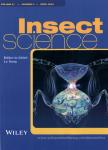Dispersal behavior of yellowjacket (Vespula germanica) queens
Dispersal behavior of yellowjacket (Vespula germanica) queens作者机构:CONICET CCT Comahue INTA Grupo de Ecologia de Poblaciones de Insectos INTA EEA Bariloche Argentina Centro Regional Universitario Bariloche U. N. del Comahue Bariloche 8400 Argentina
出 版 物:《Insect Science》 (昆虫科学(英文版))
年 卷 期:2018年第25卷第1期
页 面:109-116页
核心收录:
学科分类:0710[理学-生物学] 0830[工学-环境科学与工程(可授工学、理学、农学学位)] 07[理学] 0904[农学-植物保护] 0901[农学-作物学] 0713[理学-生态学]
基 金:financed by a grant from Consejo Nacional de Investigaciones Cientificas y Tecnicas Agencia Nacional de Promocion Cientifica y Tecnologica
主 题:flight potential German wasps hibernation invasive wasps social insect
摘 要:Understanding the factors that affect animal dispersal behavior is important from both fi.mdamental and applied perspectives. Dispersal can have clear evolutionary and ecological consequences, but for normative insect pests, dispersal capacity can also help to explain invasion success. Vespula germanica is a social wasp that, in the last century, has successfully invaded several regions of the world, showing one of the highest spread rates reported for a nonnative insect. In contrast with nonsocial wasps, in social species, queens are responsible for population redistribution and spread, as workers are sterile. For V. germanica, it has been observed that queen flight is limited to 2 distinct periods: early autumn, when new queens leave the nest to mate and find sheltered places in which to hibernate, and spring when new colonies are founded. Our aim was to study the flight behavior of V. germanica queens by focusing on the different periods in which dispersal occurs, characterizing as well the potential contribution of queen flight (i.e., distance) to the observed geographical spread. Our results suggest that the distances flown by nonover- wintered queens is greater than that flown by overwintered individuals, suggesting that the main queen dispersal events would occur before queens enter hibernation. This could relate to a behavioral trait of the queens to avoid the inbreeding with related drones. Additionally, given the short distances flown and remarkable geographical spread observed, we provide evidence showing that queen dispersal by flight is likely to contribute proportionately less to population spread than human-aided factors.



